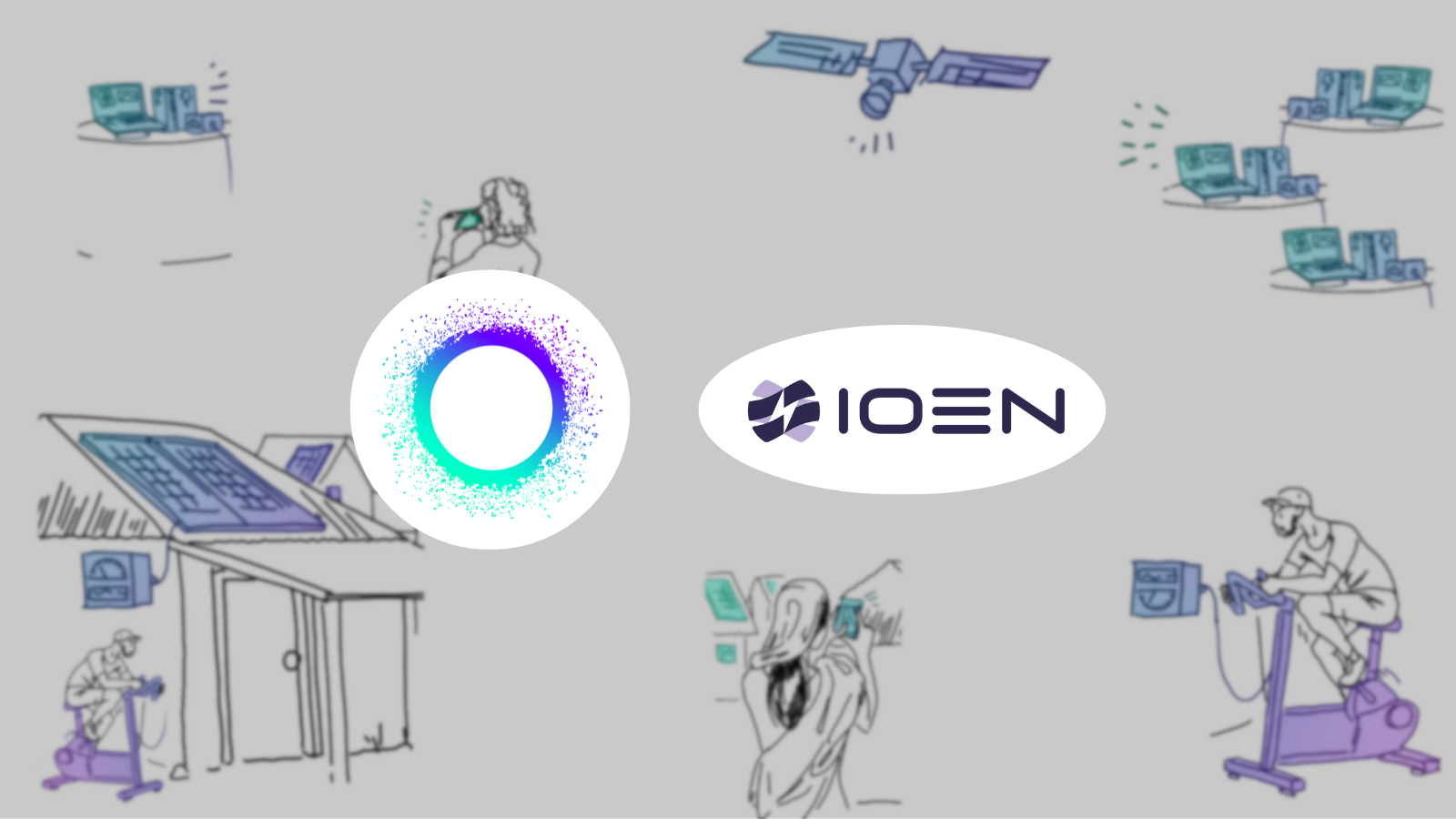Those who have been following Holochain for a while have heard of The Internet of Energy Network (IOEN). In short, IOEN’s goal is to support a sustainable energy transition by enabling microgrids of local renewables to collectively account for the energy they produce and to engage in the global financial market.
To do this, they need a way for the individuals and communities that make up these microgrids to document their energy generation in a verifiable manner.
Holochain, Rainlang, GildLab, and IOEN have teamed up to bring a working demonstration of verifiable energy to ETHDenver 2024. This will show how you can build a verifiable data system on Holochain and connect that system to an EVM, accessing financial opportunities like semi-fungible tokens and renewable energy certificates.
The Demo
To demonstrate the possibilities of verifiable energy generation at ETHDenver we are scaling down to the human level. With an Off the Grid exercise bike set up as a human powered generator, we’re asking event participants to join in and create some energy with us.
As the bike produces a charge it will be measured with a sensor on its way to charge a battery. This data is then fed into a raspberry pi running a Holochain app that will transmit this data to an auditable DHT. To tie that particular instance of energy generation to the person riding the bike, we’ll have them scan a QR code to connect the tokenproof app (which they used for their ETHDenver tickets). Along with the profile from their tickets and the measurement of energy generated, an observer will post photographic evidence of the particular person riding the bike at the particular time that energy was generated.
Then, human power credits (developed for this demo) are minted and sent to the wallet the rider connected. These are then placed into the IOEN marketplace, where they will be aggregated into IOEN renewable energy certificates (IOEN RECs), and bought and retired using IOEN tokens — showing end-to-end value, tracking and transparency of data through the Holochain app, and showcasing opportunities for liquidity in decentralized energy generation and finance.
Demonstrating Verifiable Data
The exact data fields collected are particular to this demonstration. What is important are the ways we can layer data sources, building up context so that we can verify an event that occurred in the real world.
Having multiple sources of data which authenticate the same event allows for outside observers to verify the generation of that energy, compensating the individuals who generated the energy. Holochain provides a self-validating system where this data can be stored and managed. Because you can audit not just storage but also actions within Holochain it allows data to be updated over time. And because Holochain uses distributed peer-to-peer networks, there aren’t the data limits or transaction costs of blockchains. Plus now with Rainlang, we can connect the data in Holochain to EVM transactions, securely linking the financials with the data.
This system has been developed to prototype verifiable data, and these same principles can be customized to any particular use case. Different regulators need different types of information depending on the industry. The goal is to show how multiple data sources can be layered in a self-validating environment and used to connect the digital environment to real world assets. From there, systems for automated witnessing and the validation of outputs can be developed.
The Use Case
So, what is the use case at scale?
Renewable energy certificates (RECs) offer businesses a way to offset their use of non-renewable energy by supporting renewables. Currently these certificates are measured in MWh (megawatt hours) and often require extensive reporting and expensive auditors in order to be validated. This makes them often inaccessible to small or distributed producers, as only larger generating sources (like windfarms or larger solar arrays) can bear the cost to validate their energy production and receive the right to sell their certificates.
IOEN has partnered with PV BLOX which is supporting new markets and installations for small scale solar and renewable microgrids in South East Asia. These producers are households as well as companies with solar panels on their roofs. In order to provide proof of the renewable energy that they generate, they need to gather multiple sources of data together that can then be presented to third party auditors to validate before passing that on to government agencies who issue the RECs.
For this particular use case, the data collected is mimicked in our demo with the bike. First, they need to show how much energy they are producing; this is measured by a reading off their meter. To corroborate that the energy is being generated from a renewable source, they also take a photo of their new panels. Now, all of that data collection is happening locally and is self-reported. To add an additional layer from a third party source, they also include satellite photos of before and after the solar installation. Together, all of this data from PV BLOX is then held in IOEN’s Holochain app, allowing the local producers to directly hold their data, while also having it held by the network and accessible to auditors and others as needed. Because every action within Holochain is validated, the data can’t be replaced or altered without a trail of those changes attached to the original entry. This makes it easy for auditors to verify the data collected from these multiple sources, checking the claim of energy generated against the approximate capacity to generate. This creates a ‘direct line of sight’ from auditors, regulators, and purchasers to the underlying data (amount of energy generated) supporting the asset (the REC, now on-chain).
IOEN helps PV BLOX aggregate the data from the producers so that the energy they generate can be accounted for collectively. This is then presented to auditors and the relevant agencies, and RECs are granted and then sold either bilaterally or through the IOEN/PV BLOX marketplace. The funds from that sale are then fractionalized and sent across the value chain to reward participants, including the producers based on their individual energy generation.
With integrations for tokenizing the assets almost finished, the ETHDenver demo is the prototype that shows how this will function embedded with Holochain when complete.
The Finances
So, what does any of this have to do with blockchains?
By connecting the sale and consumption of RECs to the financial markets of blockchains, we can open up a few new DeFi-driven opportunities.
For one, global liquidity and investment. For small producers, ease of fractionalization is important to scale up opportunities for finance. When a REC is sold, those profits are automatically dispersed to the producers, without the money being held up, captured opaquely, or lost in bureaucratic channels. And because the transactions are in a secure, public space, producers can check them to ensure fairness — creating upfront, open, and transparent business relations for those in the chain, and a fairer distribution of the profits.
Secondly, to increase future liquidity and financing options, IOEN is working with the new financial tool of semi-fungible tokens. In their implementation, they have fungible tokens representing units of energy which can be traded on the open market and NFTs representing RECs which can be pre-bought or held as a single MWh to offset carbon emissions. This NFT points to the data held in Holochain, showing all of the details of that particular REC, where and how the energy was produced, who audited it, etc. If that REC is to be retired or sold, the owner must balance the underlying energy value of the REC with the fungible tokens. The uniqueness of each REC will allow for a differentiation between their values, depending on the practices of their production, their level of verifiability, etc. Thus, by keeping a public account of all the relevant details, these financial tools will help encourage investment in more just and sustainable energy.
What It Means
IOEN is opening access to global financial opportunities and creating an economy of scale by aggregating small producers. This is part of a strategy for transition. By leveraging DeFi to finance a sustainable energy transition, the goal is to eventually move to a truly decentralized physical infrastructure for renewable energy generation. At some point, renewable energy certificates won’t matter because every factory, store, transportation service, and everything else we now see as polluters will be powered by locally produced renewables. Microgrids, with mutual credit currencies to manage and account for the local production and consumption of energy, auditable at the global level, will be the DePIN future for energy. IOEN is developing the tools that will help us make that transition and build the foundations of that future.



